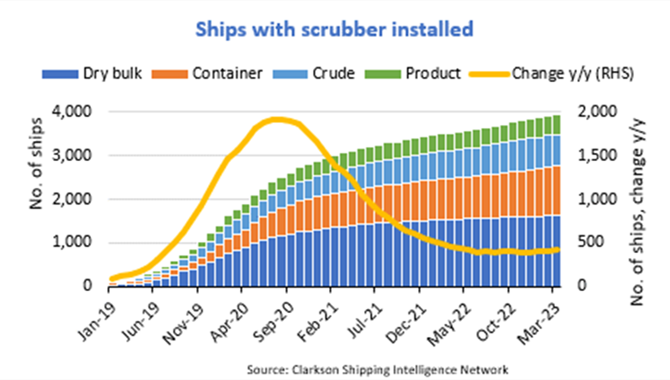“Scrubbers were installed on 399 ships in 2022, a fall of 24% y/y, and currently 13% of bulker, container, and tanker ships have a scrubber installed. Despite the slowing rate of installations, the share of ships with a scrubber is set to increase in coming years as 17% of ships in the shipyards’ order books are expected to have a scrubber installed,” says Niels Rasmussen, Chief Shipping Analyst at BIMCO.

Since 1 January 2020, ships have had to use ultra or low sulphur fuel (eg ULSFO or VLSFO) to comply with limits for sulphur emissions. However, ships can continue to use the less expensive heavy fuel oil (HFO) if they install a scrubber. But the price premium for VLSFO has turned out to be less than initially estimated.
On 31 December 2019, the day before the new IMO regulation was implemented, the price premium for VLSFO in six of the world’s largest bunkering ports averaged USD 347/tonne. Since then, the premium has averaged USD 149/tonne. It has been as low as USD 50/tonne for an extended period during 2020 and as high as USD 400/tonne during June/July 2022.
“The higher the VLSFO premium, the more attractive the investment in a scrubber is because the payback period is shorter. The lower-than-expected VLSFO premium has likely discouraged owners from installing scrubbers, particularly on smaller ships with lower bunker consumption and lower savings as a result,” says Rasmussen.
In fact, the average dry bulk, container, and tanker ship with a scrubber has a deadweight capacity of 140,845 tonnes whereas those without have an average of 51,743 deadweight tonnes. Therefore, the 13% of the dry bulk, container, and tanker ships with scrubbers represents 29% of the deadweight capacity. The crude tanker fleet has the highest installation rate with 32% of the ships and 38% of the deadweight capacity having scrubbers installed.
The percentage of ships with scrubbers is set to increase in the coming years as 17% of the dry bulk, container, and tanker ships in the shipyards’ order books are expected to have scrubbers installed. However, those 17% only amount to 24% of the deadweight capacity in the order book and the scrubber deadweight percentage could therefore decrease.
“In the long term, the use of scrubbers to cut sulphur emissions may reduce as decarbonisation efforts will increase the use of alternative fuels that are sulphur compliant,” says Rasmussen.

Since 1 January 2020, ships have had to use ultra or low sulphur fuel (eg ULSFO or VLSFO) to comply with limits for sulphur emissions. However, ships can continue to use the less expensive heavy fuel oil (HFO) if they install a scrubber. But the price premium for VLSFO has turned out to be less than initially estimated.
On 31 December 2019, the day before the new IMO regulation was implemented, the price premium for VLSFO in six of the world’s largest bunkering ports averaged USD 347/tonne. Since then, the premium has averaged USD 149/tonne. It has been as low as USD 50/tonne for an extended period during 2020 and as high as USD 400/tonne during June/July 2022.
“The higher the VLSFO premium, the more attractive the investment in a scrubber is because the payback period is shorter. The lower-than-expected VLSFO premium has likely discouraged owners from installing scrubbers, particularly on smaller ships with lower bunker consumption and lower savings as a result,” says Rasmussen.
In fact, the average dry bulk, container, and tanker ship with a scrubber has a deadweight capacity of 140,845 tonnes whereas those without have an average of 51,743 deadweight tonnes. Therefore, the 13% of the dry bulk, container, and tanker ships with scrubbers represents 29% of the deadweight capacity. The crude tanker fleet has the highest installation rate with 32% of the ships and 38% of the deadweight capacity having scrubbers installed.
The percentage of ships with scrubbers is set to increase in the coming years as 17% of the dry bulk, container, and tanker ships in the shipyards’ order books are expected to have scrubbers installed. However, those 17% only amount to 24% of the deadweight capacity in the order book and the scrubber deadweight percentage could therefore decrease.
“In the long term, the use of scrubbers to cut sulphur emissions may reduce as decarbonisation efforts will increase the use of alternative fuels that are sulphur compliant,” says Rasmussen.
The opinions expressed herein are the author's and not necessarily those of The Xinde Marine News.
Please Contact Us at:







